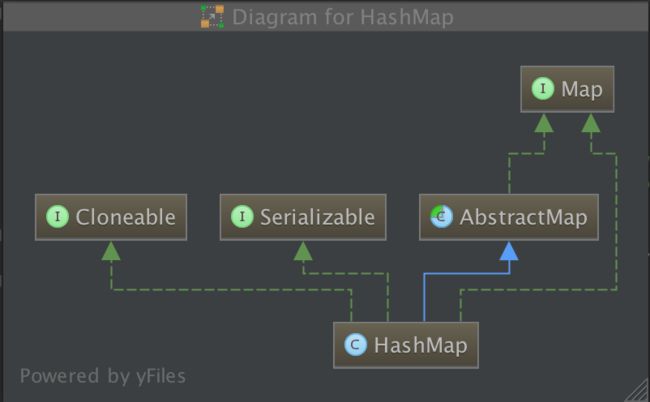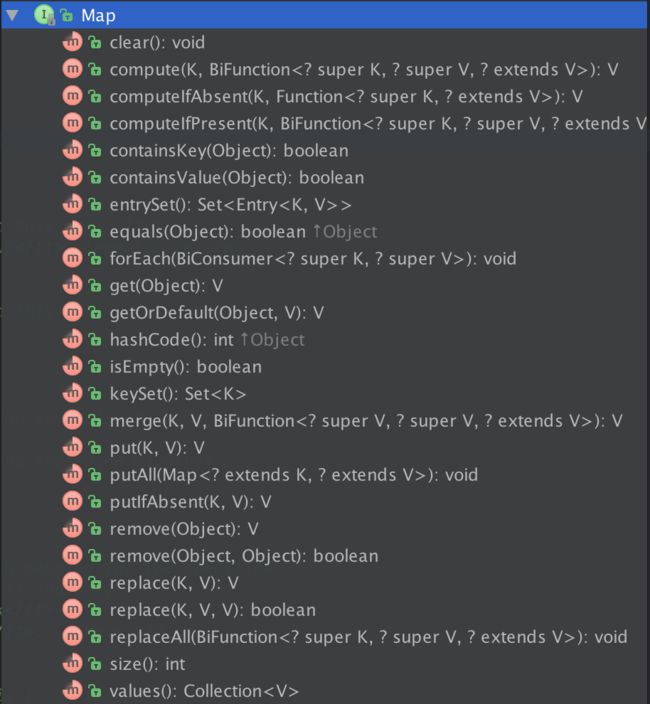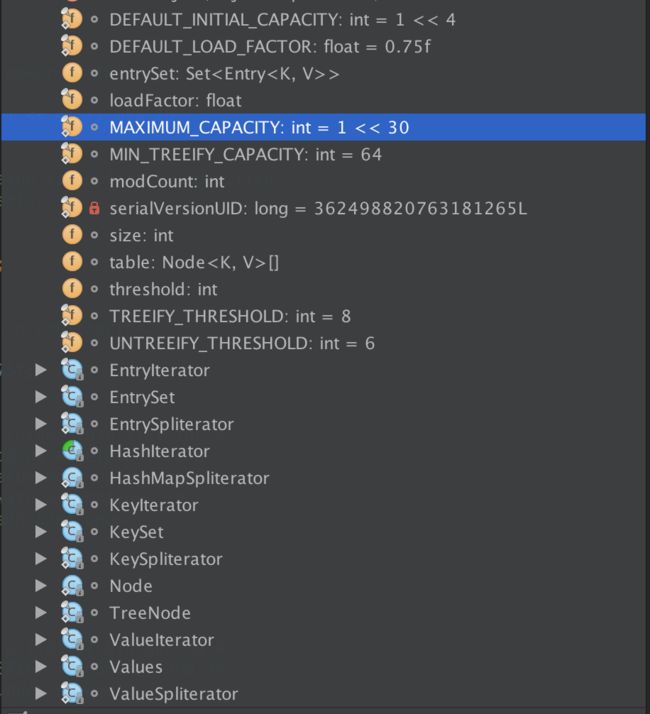java容器源码--hashmap源码解读
趁着过年有时间,把java集合中常见的几个集合的源码都稍微读了一下,写一点自己的浅见吧。以下均基于mac os x,jdk1.8,ide为InteliJ idea 14.
1、总体分析
hashmap在日常开发中使用的比较多,先hashmap的继承关系。

可以看出hashmap继承抽象类AbstractMap,实现了Cloneable, Serializable, Map接口。Cloneable, Serializable, 这2个接口为标记接口,hashmap也分别实现了writeObject、readObject、clone方法。后面会有一点writeObject的小玄机。
其中部分的接口在AbstractMap中有实现,今天主要分析hashmap中部分常用方法。
先看常量:
static final int DEFAULT_INITIAL_CAPACITY = 1 << 4; // aka 16
static final int MAXIMUM_CAPACITY = 1 << 30;
static final float DEFAULT_LOAD_FACTOR = 0.75f;这3个分别指代的含义是默认初始化容量,最大容量,默认负载因子,后面会有讲解。
static final int TREEIFY_THRESHOLD = 8;
static final int UNTREEIFY_THRESHOLD = 6;
static final int MIN_TREEIFY_CAPACITY = 64;这3个是当hash冲突时,jdk1.8所改用的红黑树的默认设定值。
transient Node[] table;
transient Set> entrySet;
transient int size;
transient int modCount;
int threshold;
final float loadFactor; 其中有4个常量有修饰符transient,这个关键词的含义是在进行序列化时,被该关键词修饰的属性或者对象不被自动序列化与反序列化。
在用迭代器进行遍历等操作时,modCount会起类似于乐观锁的作用。
而threshold可理解为hashmap的容量阈值,超过这个阈值时,则会触发一些操作(如resize);
loadFactor前面的final表明这个常量仅能被赋值一次,是该hashmap实例的负载因子,根据当前分配容量*负载因子可以计算出该hashmap实例内的size大于多少时要进行resize。
再看内部类,关键的2个:
static class Node<K,V> implements Map.Entry<K,V>;
static final class TreeNode<K,V> extends LinkedHashMap.Entry<K,V> Node与TreeNode为HashMap内部存储数据的两种不同数据结构,node为链表式结构,TreeNode为红黑树(这个,哈哈哈,忘的差不多了)
2、核心方法分析
说实话,hashmap内部的方法很多,而且部分方法1.8和1.8以下是变了个样。我选其中几个分析一下(分析的不对请指出)。
2.0 构造函数,三个
这个嘛,看看就懂了,不分析了。
2.1 tableSizeFor
static final int tableSizeFor(int cap) {
int n = cap - 1;
n |= n >>> 1;
n |= n >>> 2;
n |= n >>> 4;
n |= n >>> 8;
n |= n >>> 16;
return (n < 0) ? 1 : (n >= MAXIMUM_CAPACITY) ? MAXIMUM_CAPACITY : n + 1;
}这个方法的作用是得出hashmap的当前分配容量。进行位移操作后,那么可以保证容量是2的n次方。而hashmap中决定一个元素存储的位置是(cap-1)&hashcode,如果容量保证是2的n次方,那么末位必定是1,在进行与操作得出存储位置时,可以保证hashmap的所有位置都可以均匀的存储(key均匀分布的情况下)。
2.2 resize
final Node[] resize() {
Node[] oldTab = table;
int oldCap = (oldTab == null) ? 0 : oldTab.length;
int oldThr = threshold;
int newCap, newThr = 0;
//原hashmap有数据
if (oldCap > 0) {
//若原hashmap的数组不小于最大容量,扩到最大,返回
if (oldCap >= MAXIMUM_CAPACITY) {
threshold = Integer.MAX_VALUE;
return oldTab;
}
//原数组容量翻倍后小于最大容量,且原数组大于初始化大小,容量翻倍,阈值也翻倍
else if ((newCap = oldCap << 1) < MAXIMUM_CAPACITY &&
oldCap >= DEFAULT_INITIAL_CAPACITY)
newThr = oldThr << 1; // double threshold
}
//hashmap无数据,阈值大于0,直接将容量变成与原阈值等同大小
//这种情况是hashmap进行实例化时声明了大小
else if (oldThr > 0) // initial capacity was placed in threshold
newCap = oldThr;
//hashmap无数据,阈值为0,那么此时就为空map,赋予默认值
else { // zero initial threshold signifies using defaults
newCap = DEFAULT_INITIAL_CAPACITY;
newThr = (int)(DEFAULT_LOAD_FACTOR * DEFAULT_INITIAL_CAPACITY);
}
//新阈值为0,对应上面的第二种情况
//此时根据容量*负载因子得出一个阈值,判断扩充后的容量是否小于最大容量且新阈值是否小于最大容量,
//是:新阈值则为刚得出的值,否则新阈值则为Inter.maxValue
if (newThr == 0) {
float ft = (float)newCap * loadFactor;
newThr = (newCap < MAXIMUM_CAPACITY && ft < (float)MAXIMUM_CAPACITY ?
(int)ft : Integer.MAX_VALUE);
}
threshold = newThr;
//new一个新的node数组实例
@SuppressWarnings({"rawtypes","unchecked"})
Node[] newTab = (Node[])new Node[newCap];
table = newTab;
//原node数组不为空
//此时要将原node数组的数据复制到新的node数组实例中
if (oldTab != null) {
//遍历原node数组
for (int j = 0; j < oldCap; ++j) {
Node e;
//第j个桶不为空
if ((e = oldTab[j]) != null) {
oldTab[j] = null;
//该位置的next为空,则表明该位桶没有发生hashmap冲突
//直接将该位桶的对象放置到新node数组对应的位桶上
if (e.next == null)
newTab[e.hash & (newCap - 1)] = e;
//该位桶的next不为空,此时判断该元素是否为TreeNode的实例
//若是,则表明此时该hash位桶有冲突,且存储的数据大于8,将进行红黑树的复制
else if (e instanceof TreeNode)
((TreeNode)e).split(this, newTab, j, oldCap);
//该位桶的next不为空,且该位桶存储的非红黑树实例
//此时该位桶存储的为基于node的链表
//在保留该链表顺序的情况下进行复制
else { // preserve order
Node loHead = null, loTail = null;
Node hiHead = null, hiTail = null;
Node next;
do {
next = e.next;
//hash值和原容量进行与操作,结果为0
//因为容量只会是2的n次方,那么就是判断该对象的hash值其中一位与容量进行与操作
if ((e.hash & oldCap) == 0) {
if (loTail == null)
loHead = e;
else
loTail.next = e;
loTail = e;
}
//与的结果不为0
else {
if (hiTail == null)
hiHead = e;
else
hiTail.next = e;
hiTail = e;
}
} while ((e = next) != null);
//lo数组放在原位桶
if (loTail != null) {
loTail.next = null;
newTab[j] = loHead;
}
//hi数组放在j+oldCap位桶
if (hiTail != null) {
hiTail.next = null;
newTab[j + oldCap] = hiHead;
}
}
}
}
}
return newTab;
} 这段代码分为2大块,一块是进行扩容,一段是当原hashmap不为空时进行元素复制存储。
2.3 hash
static final int hash(Object key) {
int h;
return (key == null) ? 0 : (h = key.hashCode()) ^ (h >>> 16);
}所有对hashmap进行增删查操作,都会调用这段代码。
key不为空时,会将key的hashcode 的高位与其无符号右移16位后的数进行异或。这样做,会将高位与低位进行与操作,均匀桶位的存储。
在jdk1.8之前,这个方法如下,其中h为key.hashcode:
static int hash(int h) {
h ^= (h >>> 20) ^ (h >>> 12);
return h ^ (h >>> 7) ^ (h >>> 4);
}与1.8之前的hash方法相比,就是操作更少。至于两者的性能差异(hash冲突率、执行效率等),还有待考验。
2.4 put方法
1.8的hashmap put方法也改写了。对putval后面2个标志位不太理解。
public V put(K key, V value) {
return putVal(hash(key), key, value, false, true);
}
final V putVal(int hash, K key, V value, boolean onlyIfAbsent, boolean evict) {
Node[] tab; Node p; int n, i;
//若原hashmap为空或为空map
//resize并得出length
if ((tab = table) == null || (n = tab.length) == 0)
n = (tab = resize()).length;
//若hashmap第n-1个位桶上为空,则直接存(因为length是从1开始计数的)
if ((p = tab[i = (n - 1) & hash]) == null)
tab[i] = newNode(hash, key, value, null);
else {
Node e; K k;
//hash值相同且key相等,此时新插入的key重复,覆盖赋值
if (p.hash == hash &&
((k = p.key) == key || (key != null && key.equals(k))))
e = p;
//判断该位桶元素是否为红黑树实例,是的话进行红黑树节点插入
else if (p instanceof TreeNode)
e = ((TreeNode)p).putTreeVal(this, tab, hash, key, value);
//新插入的元素在现有位桶中不存在,且不为红黑树存储方式
//那么就要进行node链表的遍历查询
else {
for (int binCount = 0; ; ++binCount) {
//下一个元素无值
if ((e = p.next) == null) {
//new一个新链表节点
p.next = newNode(hash, key, value, null);
//若该位桶存储的数据个数不小于7,则该位桶转化为红黑树存储
if (binCount >= TREEIFY_THRESHOLD - 1) // -1 for 1st
treeifyBin(tab, hash);
break;
}
//hash值相同且key相等,此时则说明该key在位桶中存在,覆盖赋值后终端
if (e.hash == hash &&
((k = e.key) == key || (key != null && key.equals(k))))
break;
//向后继续循环
p = e;
}
}
//该位桶存储对象不为空
if (e != null) { // existing mapping for key
V oldValue = e.value;
//onlyIfAbsent在hashmap中为false
//将value赋值给该位桶首个对象
if (!onlyIfAbsent || oldValue == null)
e.value = value;
//linkedhashmap使用
//设计的比较巧妙
afterNodeAccess(e);
return oldValue;
}
}
//并发控制标志位,作用类似于乐观锁
++modCount;
//当前size自增后大于该hashmap实例阈值,重新分配空间
if (++size > threshold)
resize();
//linkedHashmap使用
afterNodeInsertion(evict);
return null;
} 从这段代码也可以看出,在进行对象插入的时候,也是要先判断对象是否在位桶中存在,并且根据位桶的情况进行插入操作。
2.5 get操作
public V get(Object key) {
Node e;
return (e = getNode(hash(key), key)) == null ? null : e.value;
}
final Node getNode(int hash, Object key) {
Node[] tab; Node first, e; int n; K k;
//table不为空,n-1位桶存储对象不为空
//否则返回null
if ((tab = table) != null && (n = tab.length) > 0 &&
(first = tab[(n - 1) & hash]) != null) {
//判断n-1位桶的第一个元素的key是否等同于入参key
if (first.hash == hash && // always check first node
((k = first.key) == key || (key != null && key.equals(k))))
return first;
//遍历n-1位桶
if ((e = first.next) != null) {
//若n-1位桶为红黑树,遍历之
if (first instanceof TreeNode)
return ((TreeNode)first).getTreeNode(hash, key);
//n-1位桶不为红黑树,循环该位桶
do {
//链表该节点的hash是否与入参相同,key是否相等
//是则返回该节点
//否则继续下一次循环
if (e.hash == hash &&
((k = e.key) == key || (key != null && key.equals(k))))
return e;
} while ((e = e.next) != null);
}
}
return null;
} get方法与put方法类似
2.6 remove
public V remove(Object key) {
Node e;
return (e = removeNode(hash(key), key, null, false, true)) == null ?
null : e.value;
}
final Node removeNode(int hash, Object key, Object value,
boolean matchValue, boolean movable) {
Node[] tab; Node p; int n, index;
//类似于getNode
if ((tab = table) != null && (n = tab.length) > 0 &&
(p = tab[index = (n - 1) & hash]) != null) {
Node node = null, e; K k; V v;
if (p.hash == hash &&
((k = p.key) == key || (key != null && key.equals(k))))
node = p;
else if ((e = p.next) != null) {
if (p instanceof TreeNode)
node = ((TreeNode)p).getTreeNode(hash, key);
else {
do {
if (e.hash == hash &&
((k = e.key) == key ||
(key != null && key.equals(k)))) {
node = e;
break;
}
p = e;
} while ((e = e.next) != null);
}
}
//该位桶存储对象不为空,且,
//标志位matchvalue为false或节点的value与key相同或者相等
if (node != null && (!matchValue || (v = node.value) == value ||
(value != null && value.equals(v)))) {
//红黑树节点,进行红黑树节点删除操作
if (node instanceof TreeNode)
((TreeNode)node).removeTreeNode(this, tab, movable);
//非红黑树节点
//首节点,指针后移
else if (node == p)
tab[index] = node.next;
//非首节点,指针后移
else
p.next = node.next;
//并发控制
++modCount;
//从这个地方可以看出size是怎么得出的
//size为所有元素,length为位桶的数据
--size;
//linkedHashmap使用
afterNodeRemoval(node);
return node;
}
}
return null;
} remove与put、get不同在于其进行remove时,可能涉及要进行指针后移
2.7 writeObject 序列化
private void writeObject(java.io.ObjectOutputStream s)
throws IOException {
int buckets = capacity();
// Write out the threshold, loadfactor, and any hidden stuff
s.defaultWriteObject();
s.writeInt(buckets);
s.writeInt(size);
internalWriteEntries(s);
}还记得上面说的关于序列化的彩蛋么,that’s it.
这段代码比较隐藏的亮点在s.writeInt(size);
先看hashmap的内部全局变量transient Node[] table;这个node数组使用了transient修饰符,表明该node数组不参与序列化。而在数据传输,又必须要进行序列化,那么就在writeObject内显式的使用node的size来表明有多少个对象需要进行序列化,避免对空对象进行序列化,节约资源。
关于java序列化机制,我还有一篇文章,有兴趣可以看看。
http://blog.csdn.net/zclzhangcl/article/details/50755798
3、小结
这篇文章其实还有很多没写到的地方,比如序列化的io机制,位桶存储之红黑树(说实话,也没深入去了解)。若不限于源码解读,hashmap里面还有很多值得分析的内容,如由在hash冲突时存储结构由纯链表改为链表+红黑树的原因及效率分析,并发异常等。
后续还有java容器的其他源码解读,也欢迎阅读和指出其中的错误之处。

